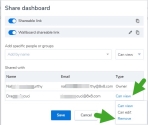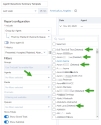Share and edit custom reports
As a supervisor, you can view, edit, and schedule custom reports. You can also share custom reports you create with your coworkers. Let’s say you want to share a custom report with your fellow supervisor, simply share the report with one of the two levels of access permissions:
- View: The user can see the report configuration that the owner does, can copy and can schedule the report but cannot delete or edit the report configuration.
- Edit: The user can view, edit, schedule, and delete the report. All changes made by the user who received the report with edit permission will be visible to everyone with whom the report has been shared.
Note: Only the report configuration is being shared, not the access to the data. Let’s say John shares a custom report with his coworker Robin to view. John supervises tier 1 and tier 2 groups, while Robin supervises Tier 1 group only; When Robin logs in, she can see the shared report under Custom reports and views the data for Tier 1 group that she supervises and not the data for Tier 2.
To share a custom report:
-
From the list of custom reports, click
 next to the desired report and select Share from the menu.
next to the desired report and select Share from the menu. OR
When a custom report is open, click
 in the header to access the sharing options.
in the header to access the sharing options. - In the pop-up dialog, select individuals or groups from the list to share the report with.
-
Set the permission to view or edit and save the settings.
-
To share the reports with external parties who do not have access to 8x8 Analytics for Contact Center, enable the following choices:
- Share report as CSV
- Share report as Excel
-
Click
 to copy the link and share it with group members or external users who do not have access to these reports.
to copy the link and share it with group members or external users who do not have access to these reports.
Note: To revoke access to these reports via the links, simply disable these settings.
If Robin edits this custom report, all users who have access to the report will see the changes Robin made. Robin can clone and edit the report without impacting the original report owned by John.
You can also make updates to an existing report and save those changes.
To edit a custom report:
-
From the list of custom reports, click
 next to the desired report and select Edit from the menu.
next to the desired report and select Edit from the menu. OR
When a custom report is open, click Edit in the header.
-
A list of available options displays.
- Report configuration: You can group your dimensions and select to view them in the report by clicking
 .
. - Metrics: You can choose to display agent and queue metrics by clicking
 .
. - Filters: You can choose to select and filter by Groups, Agents, Media, and Queues.
- Show Totals: You can enable the toggle for Show Grand Total to display the aggregated total for each selected metric. Enabling the toggle for Show Subtotal and Show Charts displays a visual chart of the sum of your selected metrics.
- Preview: Selecting this option displays a preview of the report.
- Report configuration: You can group your dimensions and select to view them in the report by clicking
- Click Save to update the report with your selections.
Note: If you disable the Show Subtotal toggle, the Show Charts toggle will be disabled as well.
Removing access to a shared report
The access to the shared report can be removed at any time by the owner. Removing the view and edit permissions will also discontinue all emails scheduled for this report by the user whose permissions are being revoked. Let's say John shared his dashboard and wallboard links with his boss Emily. Emily has edit rights to edit the dashboard and view the metrics for John’s queues. Emily has recently moved to another role and does no longer need access to these reports, John can remove Emily's access to his reports.
Simply open the custom report, click ![]() in the header to open the sharing settings, click the option to view or edit and select Remove from the drop-down list of choices.
in the header to open the sharing settings, click the option to view or edit and select Remove from the drop-down list of choices.
Note: To revoke access to these reports via the links, simply disable the settings to share reports as CSV or Excel.
Generating report for deleted agents
While defining a report, you can now spot the deleted agents quickly as they are marked as deleted. Let’s say you want to track the agent performance of active agents, you can exclude deleted agents rather quickly. Deleted agent data will also be visible for Today’s metrics on dashboards, if the agent has data from today prior to their deletion. This capability is available via our public APIs as well.
Note: Deleted agents will be grouped under one single section labeled as No Group.


